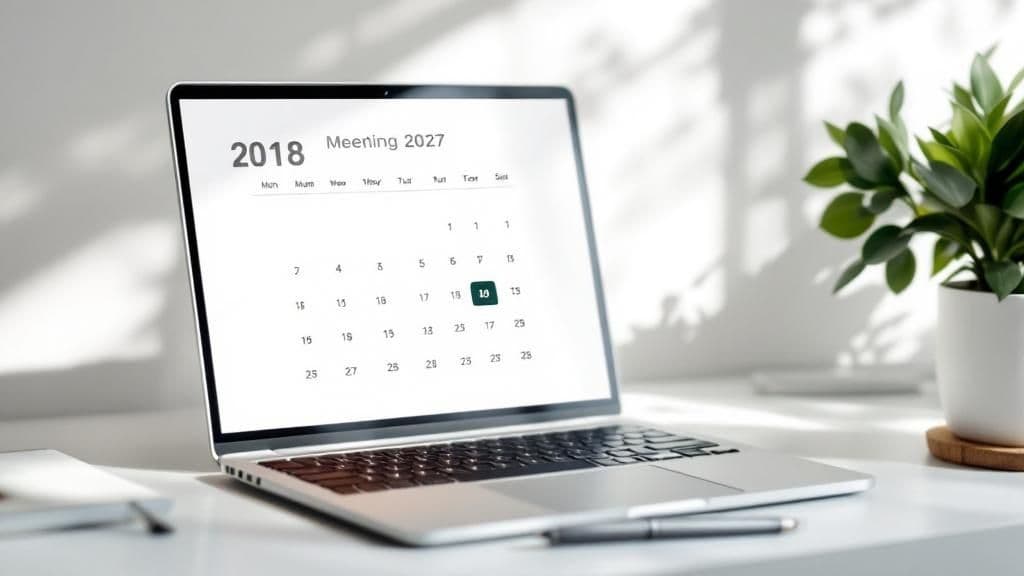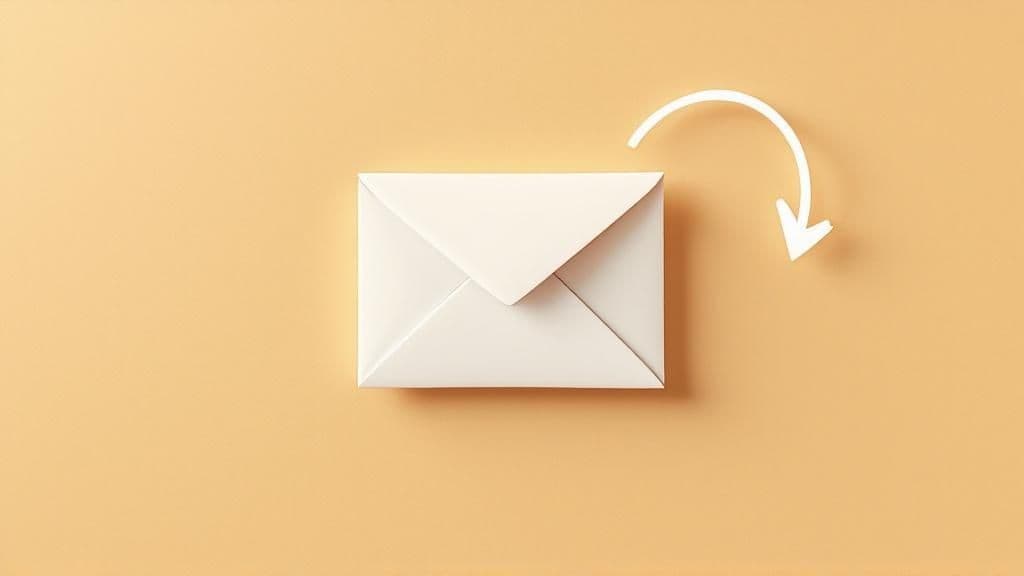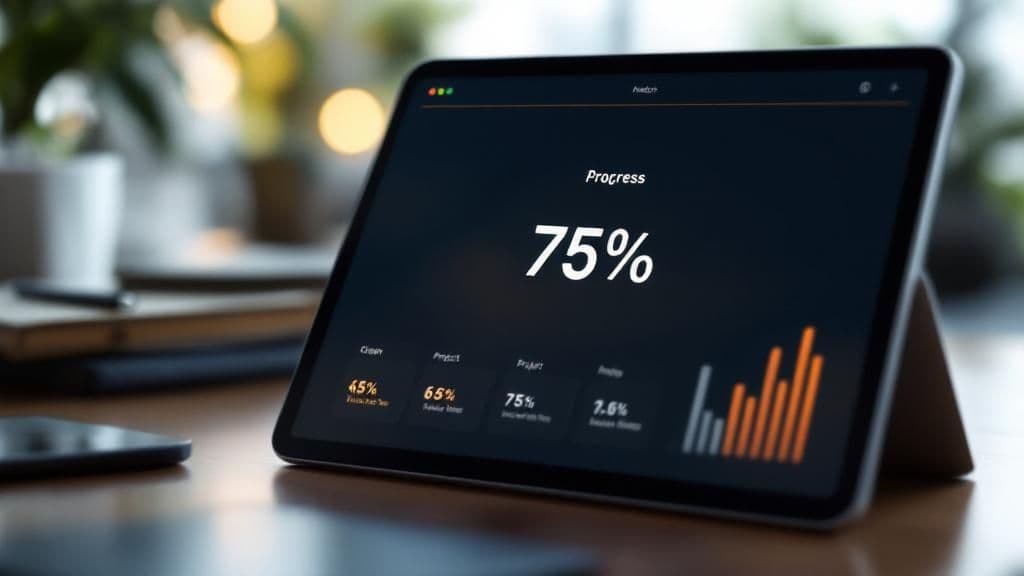8 Professional Email Examples & Templates for 2025
Level up your inbox with our 8 professional email examples. Get expert-backed templates and tips for job applications, follow-ups, networking, and more.

Crafting the perfect email can feel like a high-stakes puzzle. You’re staring at a blank screen, trying to sound professional yet approachable, direct yet polite. It’s a common bottleneck that pulls you out of your workflow, whether you're a freelancer pitching a new client, a founder connecting with investors, or a marketer sending a crucial project update. The right words can open doors, while the wrong ones can close them just as quickly. That’s why having a solid set of professional email examples is more than just a convenience; it's a strategic advantage.
This guide isn’t just a list of templates to copy and paste. We’re going deeper. For each scenario, we’ll break down a powerful example, revealing the specific tactics and psychological triggers that make it effective. You'll get actionable takeaways and replicable strategies you can immediately apply to your own communications.
Forget writer's block. This collection is your new playbook for writing emails that get results. We'll cover everything from making a warm introduction and requesting a meeting to sending a persuasive sales proposal and resolving a customer complaint. Let's dive in and transform your inbox from a source of stress into a tool for growth.
1. Meeting Request Email
Few things can derail a project faster than a poorly executed meeting request. A vague email leads to endless back-and-forth, confusion, and wasted time. A well-crafted meeting request, however, is a productivity powerhouse. It sets clear expectations, respects everyone's schedule, and ensures the meeting starts on the right foot before it even begins. This is one of the most fundamental professional email examples you'll master.

Example: Project Kickoff Meeting
Subject: Request: Project Alpha Kickoff Meeting - Week of Oct 21
Hi Team,
I'd like to schedule a 30-minute kickoff meeting for Project Alpha to align on goals, timelines, and roles. I've attached a brief agenda for your review.
Please let me know which of the following times works best for you:
- Tuesday, Oct 22 at 10:00 AM EST
- Wednesday, Oct 23 at 2:30 PM EST
- Thursday, Oct 24 at 11:00 AM EST
The meeting will be held via Google Meet (link to follow in the calendar invite). If none of these times work, please suggest an alternative.
Looking forward to getting started!
Best,
Alex
Why This Works & Actionable Takeaways
This email is a masterclass in efficiency and clarity. It respects the recipient's time by getting straight to the point and providing all necessary information upfront, which is a key principle of professional communication.
- Action-Oriented Subject: The subject line "Request: Project Alpha Kickoff Meeting" is impossible to misinterpret. It clearly states the purpose (kickoff meeting) and the project, making it easy to find and prioritize.
- Clear Purpose: The first sentence immediately states the meeting's goal and duration. This allows recipients to gauge its importance and time commitment instantly.
- Pre-emptive Information: Attaching the agenda before the meeting is a pro move. It shows you're prepared and allows attendees to come with questions and ideas, making the meeting itself more productive.
- Reduces Scheduling Friction: Providing 2-3 specific time options drastically cuts down on scheduling emails. It puts the ball in their court but gives them easy choices. For more in-depth strategies on this, check out these effective meeting invitation email tips to help boost your attendance and engagement.
2. Follow-up Email
The space between conversations is where opportunities are often lost. A strategic follow-up email is the bridge that closes that gap, turning a single interaction into a sustained relationship or a completed project. Whether after an interview, a sales pitch, or a networking event, a polite and value-driven follow-up keeps you top-of-mind and demonstrates professionalism and initiative. Mastering this is crucial, as it’s one of the most versatile professional email examples in any professional's toolkit.

Example: Following Up After a Sales Proposal
Subject: Following up on the Project Phoenix Proposal
Hi Jamie,
Hope you've had a productive week.
I'm writing to follow up on the proposal I sent over last Tuesday for Project Phoenix. I wanted to see if you had any initial thoughts or questions I could help clarify.
Since we last spoke, I came across an article about boosting user engagement with gamification-a key goal we discussed-and thought you might find it interesting: [Link to relevant article].
Let me know if you anticipate having an update next week. I'm happy to schedule a brief 15-minute call to walk through any part of the proposal.
Best regards,
Samantha
Why This Works & Actionable Takeaways
This email avoids the dreaded "just checking in" trap by adding new value. It shows you're still thinking about their needs, which strengthens the relationship even if a decision hasn't been made.
- A Subject That's Easy to Search: The subject line is direct and includes the project name, making it simple for Jamie to find the original proposal and context. For more ideas on crafting compelling subject lines, explore these professional email subject lines to improve your open rates.
- Provides New Value: The core strength of this email is the linked article. Instead of just asking for an update, Samantha offers something helpful and relevant, reinforcing her expertise and genuine interest in solving Jamie's problem.
- Gentle Nudge, Not a Demand: The tone is patient and helpful. It frames the follow-up as an offer to assist ("clarify," "walk through") rather than a push for a decision, which respects the recipient's timeline.
- Clear, Low-Friction Next Step: Offering a "brief 15-minute call" is a low-commitment call-to-action. It's an easy "yes" for a busy person who might be hesitant to block off a full hour. This makes it more likely for the conversation to continue.
3. Project Update Email
Keeping stakeholders in the loop is critical for any project's success. A project update email is your best tool for maintaining transparency, managing expectations, and ensuring everyone stays aligned. Without regular, structured updates, stakeholders can become anxious, priorities can drift, and small issues can escalate into major problems. Mastering this type of communication is a hallmark of truly effective project management and a core skill demonstrated in top-tier professional email examples.

Example: Weekly Client Project Report
Subject: Project Update: Phoenix Website Redesign - Week of Oct 21
Hi Client Team,
Here is our progress report for the Phoenix Website Redesign project for the week ending October 25th.
Overall Status: Green (On Track)
What We Accomplished This Week:
- Completed the final wireframes for the homepage and product pages.
- Received and implemented feedback on the initial brand style guide.
- Began development on the back-end user authentication module.
Upcoming Next Steps:
- Begin high-fidelity mockups for key pages (due Nov 1).
- Finalize database schema and API endpoints (due Nov 4).
Blockers or Risks:
- None at this time. We are waiting on the final product photography, which is still on schedule for delivery next week.
Please let me know if you have any questions.
Best regards,
Jamie
Why This Works & Actionable Takeaways
This email is a perfect example of clarity and proactive communication. It gives the client a comprehensive overview in under 30 seconds, building trust and confidence in the project's direction. It anticipates questions and provides clear, digestible information.
- Scannable Subject Line: The subject includes the project name and a time-bound reference ("Week of Oct 21"). This makes it easy for the client to search for and file, creating an organized record of communication.
- Lead with the Bottom Line: The "Overall Status: Green" immediately tells the recipient the most important piece of information. This high-level summary respects their time and allows them to relax before diving into the details.
- Structured with Headings: Using bolded headings like "What We Accomplished" and "Blockers or Risks" breaks the email into logical, scannable sections. The recipient can quickly find the information that matters most to them.
- Focus on Action and Future: The email doesn't just report on the past; it clearly defines "Upcoming Next Steps." This keeps the project momentum going and shows the client you have a forward-looking plan, reinforcing your role as a competent professional.
4. Introduction/Networking Email
Sending a cold networking email can feel intimidating, but it's a critical skill for building professional relationships and unlocking new opportunities. A great introduction email breaks through the noise of a crowded inbox by being personal, value-driven, and respectful of the recipient's time. Instead of a generic "let's connect," a well-researched message shows genuine interest and lays the foundation for a meaningful relationship, making it one of the most powerful professional email examples in your toolkit.

Example: Following Up with a Conference Speaker
Subject: Following up from the SaaS Growth Summit
Hi Dr. Evans,
I was in the audience for your keynote, "Scaling Beyond the First 1,000 Customers," at the SaaS Growth Summit last week, and I was blown away by your insights on product-led growth. Your point about leveraging community forums as an early feedback channel really resonated with me.
As the founder of a small but growing analytics startup, I'm currently navigating that exact challenge.
I know you're incredibly busy, but I'd be grateful for the chance to ask you a couple of quick questions about your experience. Would you be open to a brief 15-minute call sometime in the next few weeks?
Best regards,
Samantha Jones
Why This Works & Actionable Takeaways
This email succeeds because it is specific, genuine, and makes a low-friction request. It avoids the common mistake of being vague and demonstrates that the sender has done their homework, immediately setting them apart from the crowd.
- Specific and Flattering Subject: The subject line instantly provides context. "Following up from the SaaS Growth Summit" reminds the recipient where they might know the sender from and makes it more likely to be opened.
- Show You Were Listening: The first paragraph doesn't just say "I enjoyed your talk." It mentions the specific title and a key takeaway. This proves genuine interest and makes the compliment feel authentic, not transactional.
- Create a Personal Connection: By briefly mentioning her own startup and its challenges, Samantha creates a point of connection. This transforms the email from a fan message into a peer-to-peer conversation.
- Low-Commitment Ask: The request for a "brief 15-minute call" is far less daunting than an open-ended "let's chat." It respects Dr. Evans's time and makes it much easier for her to say yes. This shows you value their time as much as their insight.
5. Thank You Email
Sending a thank you email is more than just a polite gesture; it's a strategic move that strengthens professional relationships and keeps you top-of-mind. Whether it's after an interview, a client meeting, or a helpful conversation, a well-timed thank you note demonstrates gratitude, professionalism, and attention to detail. Neglecting this simple step can make you seem forgettable, while a thoughtful one can set you apart from the competition. Mastering this is a cornerstone of using professional email examples effectively.
Example: Post-Interview Thank You
Subject: Thank you - Following up on the Product Manager interview
Hi Dr. Evans,
Thank you again for your time this morning. I truly enjoyed our conversation about the Product Manager role and learning more about your team's innovative approach to user-centric design.
I was particularly excited about the new mobile platform initiative you mentioned. My experience in launching the "ConnectApp" at my previous company, which grew its user base by 40% in six months, aligns well with the challenges and opportunities you described.
I am very enthusiastic about the possibility of joining your team and am confident I have the skills to help you achieve your goals. Please let me know if there is any other information I can provide.
Thank you for your consideration.
Best regards,
Jamie Doe
Why This Works & Actionable Takeaways
This email succeeds by being timely, specific, and value-oriented. It goes beyond a simple "thanks" to actively reinforce the sender's qualifications and enthusiasm for the role, making it a powerful follow-up tool.
- Specific and Personalized: Mentioning the "user-centric design" approach and the "mobile platform initiative" proves active listening. It shows you were engaged, not just going through the motions.
- Connects Experience to Needs: The email doesn't just restate a resume point. It strategically connects past success ("ConnectApp" growth) directly to a specific challenge the interviewer mentioned. This reinforces Jamie's value proposition.
- Prompt but Professional: Sending a thank you within 24 hours is key. It shows you are organized and eager. The tone remains warm and professional without being overly casual or desperate.
- Reinforces Enthusiasm: The closing lines clearly state excitement for the role. This positive energy can be a deciding factor for hiring managers choosing between similar candidates. For more guidance on perfecting your tone, these professional email writing tips offer excellent advice.
6. Complaint Resolution Email
Handling a customer complaint is a make-or-break moment. A clumsy, defensive, or slow response can turn a manageable issue into a public relations nightmare and lose you a customer for life. Conversely, a thoughtful, empathetic, and effective complaint resolution email doesn't just solve a problem; it can build even stronger loyalty. This is one of the most powerful professional email examples for turning a negative experience into a positive one.
Example: E-commerce Order Issue
Subject: Regarding Your Recent Order #A58B39-2 - Let's Make This Right
Hi Jessica,
I'm so sorry to hear that the ceramic mug in your order (#A58B39-2) arrived damaged. I understand how disappointing that must be, especially when you were looking forward to it. Please accept my sincere apologies for this.
I've already processed a new order for a replacement mug, which will be shipped out today via express post at no charge to you. You should receive a separate shipping confirmation email shortly. There's no need to return the damaged item.
We're also reviewing our packaging procedures for fragile items to prevent this from happening again. As a small token of our apology, I've added a $10 store credit to your account for your next purchase.
If there's anything else I can do, please let me know.
Sincerely,
Mark Customer Success Manager
Why This Works & Actionable Takeaways
This email excels by taking ownership, acting decisively, and showing genuine care. It neutralizes frustration and demonstrates that the company values its customers beyond a single transaction.
- Human-First Apology: The email opens with empathy ("I'm so sorry to hear," "I understand how disappointing that must be"). It acknowledges the customer's feelings before jumping into solutions, which is crucial for de-escalation.
- Immediate Ownership: Using "I" statements like "I'm so sorry" and "I've already processed" takes personal responsibility. This is far more effective than a vague corporate "we apologize for the inconvenience."
- Solution Over Process: Mark doesn't ask the customer what they want; he provides an immediate, no-hassle solution (shipping a replacement, no return needed). This removes all friction for the customer.
- Goes Above and Beyond: Offering a store credit is a classic service recovery tactic. It apologizes for the past mistake and incentivizes a future positive experience, reinforcing the relationship. Beyond the email itself, mastering the art of resolution can be achieved by applying effective tips for dealing with customer complaints.
7. Sales Proposal Email
Sending a sales proposal is a critical moment in any sales cycle. This isn't just about listing prices; it's about presenting a solution to a client's specific problem. A weak proposal email can feel generic and pushy, instantly killing a deal. A strong one, however, builds a compelling business case, demonstrates your understanding of their needs, and positions your offer as the ideal solution. Mastering these professional email examples is key to converting leads into loyal customers.
Example: SaaS Solution Proposal
Subject: Proposal: A Plan to Increase [Client Company Name]'s Team Productivity
Hi [Client Name],
Thank you for your time on our call yesterday. It was great learning about your goals to streamline project management and boost team efficiency.
Based on our discussion, I've put together a detailed proposal outlining how our platform can help you achieve a 15-20% increase in productivity within the first quarter. The attached document covers the implementation plan, user training, and a transparent pricing breakdown.
In short, we'll help you:
- Automate repetitive tasks to save each team member 5+ hours per week.
- Centralize communication to reduce errors and project delays.
- Gain real-time insights with our advanced analytics dashboard.
Please let me know if you have any questions after reviewing the proposal. I'm available to walk you through it on a quick 15-minute call next week.
Best regards,
Sarah
Why This Works & Actionable Takeaways
This email succeeds because it's entirely client-centric. It focuses on solving the prospect's problems, not just selling a product. It frames the proposal as a solution, making it a valuable resource rather than a simple sales pitch.
- Benefit-Driven Subject Line: The subject line "[Proposal] A Plan to Increase..." immediately frames the email around a tangible benefit for the client, making it much more compelling to open.
- Personalized Opening: Referencing the previous conversation shows you were listening and that this isn't a generic blast. It builds rapport and sets a collaborative tone.
- Scannable Key Benefits: The bullet points are a brilliant touch. They summarize the core value propositions and connect features directly to outcomes (e.g., "save 5+ hours per week"), making the ROI clear and easy to grasp. When crafting your sales proposals, leveraging effective cold email templates for sales can significantly improve your outreach success.
- Clear, Low-Friction CTA: The email keeps the core message concise and directs the reader to the detailed attachment. The call-to-action is a soft, low-commitment "15-minute call," which is much more approachable than asking them to make a purchase decision immediately. For more tips on this, you can learn more about AI email writing for sales on typeboost.ai.
8. Announcement Email
Announcements are high-stakes communications. Whether you're unveiling a new feature, announcing a key hire, or updating company policy, clarity is paramount. A poorly handled announcement can create confusion, anxiety, and distrust. A great one, however, builds excitement, fosters transparency, and ensures everyone is aligned and informed. Getting these right is a crucial skill, making this a vital category of professional email examples.
Example: New Feature Launch
Subject: Big News! Introducing Automated Reporting in Our Platform
Hi [Customer Name],
Get ready to save hours of manual work! We're thrilled to announce the launch of our most-requested feature: Automated Reporting.
Starting today, you can schedule daily, weekly, or monthly reports to be sent directly to your inbox or Slack channel. This has been a top priority for our team, and we can't wait for you to try it.
You can learn more about how it works in our new blog post or dive right in by visiting your dashboard.
Thanks for being a valued member of our community.
Best,
The Team at [Company Name]
Why This Works & Actionable Takeaways
This email expertly builds excitement while delivering essential information. It avoids jargon and focuses entirely on the user's benefit, which is the key to any successful product announcement. It’s a perfect example of customer-centric communication.
- Benefit-Driven Subject Line: The subject line "Big News! Introducing Automated Reporting" creates intrigue and immediately states the announcement's purpose. It’s exciting and informative.
- Lead with the "Why": The email opens by telling the user how this new feature will improve their life ("save hours of manual work"). This hooks them in before explaining the "what."
- Provide Clear Next Steps: The message doesn't just announce the feature; it gives users clear, actionable paths. They can either learn more via the blog or start using the feature immediately, catering to different user preferences.
- Maintain a Positive Tone: The enthusiastic language ("thrilled to announce," "can't wait for you to try it") reinforces the positive nature of the update and strengthens the company-customer relationship.
Professional Email Types Comparison Table
| Email Type | Implementation Complexity 🔄 | Resource Requirements ⚡ | Expected Outcomes 📊 | Ideal Use Cases 💡 | Key Advantages ⭐ |
|---|---|---|---|---|---|
| Meeting Request Email | Moderate: Requires scheduling details and agenda | Low to Moderate: Time to draft and coordinate | Clear expectations and accountability | Scheduling team syncs, client meetings, reviews | Sets clear expectations; organized preparation |
| Follow-up Email | Low: Simple structure but requires personalization | Low: Minimal time per email, some research | Maintains continuity, increases response rates | Post-interview, proposal follow-ups, networking | Enhances response rates; professional persistence |
| Project Update Email | High: Detailed metrics, risk analysis, next steps | Moderate to High: Data gathering and formatting | Keeps stakeholders engaged and aligned | Agile sprints, client reporting, quarterly updates | Prevents scope creep; provides accountability |
| Introduction/Networking Email | Moderate: Needs research and personalized content | Low to Moderate: Time for customization | Opens new opportunities and builds relationships | New contacts, LinkedIn connections, referrals | Builds network; proactive professional approach |
| Thank You Email | Low: Brief and courteous | Low: Quick to draft but requires personalization | Strengthens relationships and differentiates sender | Post-interview, client appreciation, team thanks | Demonstrates professionalism; increases future opportunities |
| Complaint Resolution Email | High: Careful wording and solution articulation | Moderate to High: Time-consuming for complex cases | Transforms negative experiences; restores trust | Customer complaints, service issues, billing errors | Enhances customer satisfaction and loyalty |
| Sales Proposal Email | Moderate to High: Tailored solutions and pricing | Moderate: Requires research and documentation | Presents compelling cases; supports sales conversions | Product/service proposals, consulting pitches | Scalable outreach; detailed presentations |
| Announcement Email | Moderate: Clear message and impact explanation | Moderate: Coordination and careful wording | Ensures consistent communication; transparency | Product launches, restructuring, policy updates | Prevents rumors; official communication record |
Mastering Your Inbox: Beyond the Templates
So, there you have it: a deep dive into the architecture of effective communication. We’ve moved beyond simply providing a list of professional email examples and instead dismantled the strategy behind each one. From securing a critical meeting to gracefully handling a customer complaint, the right email can be a powerful tool for building relationships, driving projects forward, and shaping your professional reputation.
The biggest takeaway isn't just about copying and pasting. It’s about understanding the why behind the what. Each template we explored is built on a foundation of core principles: clarity, empathy, and a clear call to action. These aren't just emails; they're strategic assets.
Your Action Plan for Email Excellence
Let's distill the core strategies from this guide into a repeatable action plan. The goal is to internalize these concepts so you can adapt them to any situation, not just the ones we covered.
- Deconstruct Before You Construct: Before writing, always ask: What is the single most important outcome I want from this email? This North Star will guide every word you choose.
- Lead with Value, Not an Ask: Whether you’re networking or sending a project update, frame your message around the recipient's perspective. How does this benefit them? How does it make their life easier?
- Clarity is King (and Queen): Use short sentences, clear subheadings, and bold text to guide your reader's eye. A scannable email is a readable email. Don't make people hunt for the point.
- The "One Thing" Rule: Every email should have one primary call to action. Asking for too many things at once creates confusion and inaction. Make it painfully obvious what the next step is.
Mastering these professional email examples is more than just an administrative skill; it’s a career accelerator. In a world saturated with digital noise, the ability to communicate with precision and professionalism cuts through the chaos. It builds trust with clients, fosters collaboration with colleagues, and ultimately, opens doors to new opportunities. Think of each email you send as a micro-representation of your personal brand. Is it clear, respectful, and effective? By applying the strategic frameworks we've discussed, you ensure the answer is always a resounding "yes."
Tired of manually crafting the perfect email every single time? TypeBoost integrates directly into your workflow, helping you write faster, smarter, and with more confidence across any app or website. Get instant access to powerful AI writing assistance, tone adjustments, and custom templates without ever leaving your text editor. Check out TypeBoost and see how it can transform your professional communication.